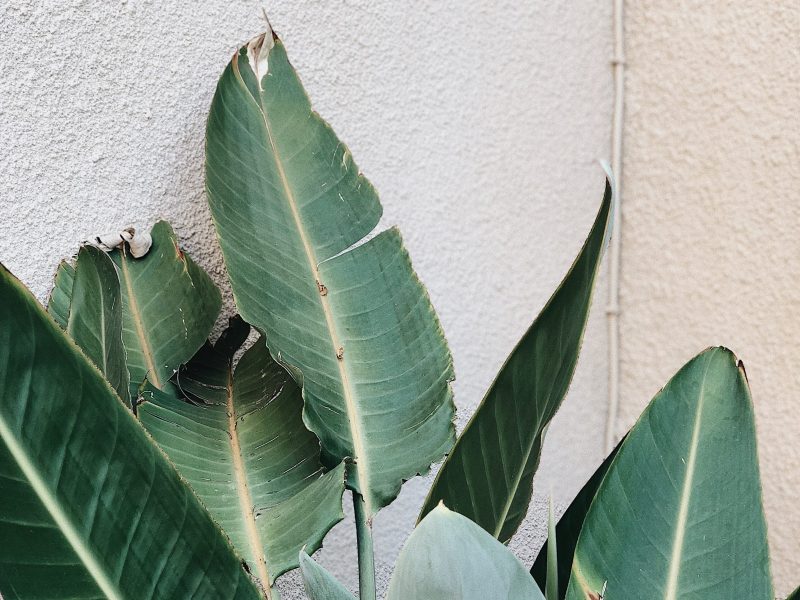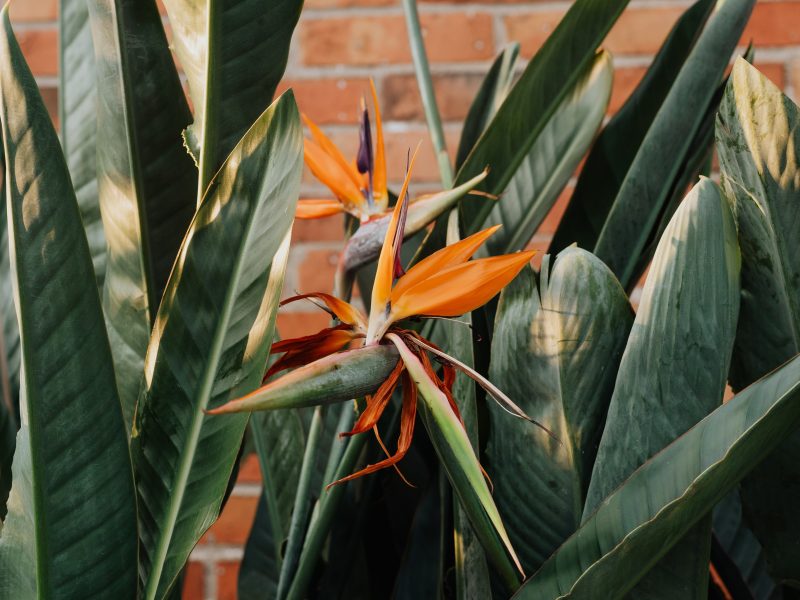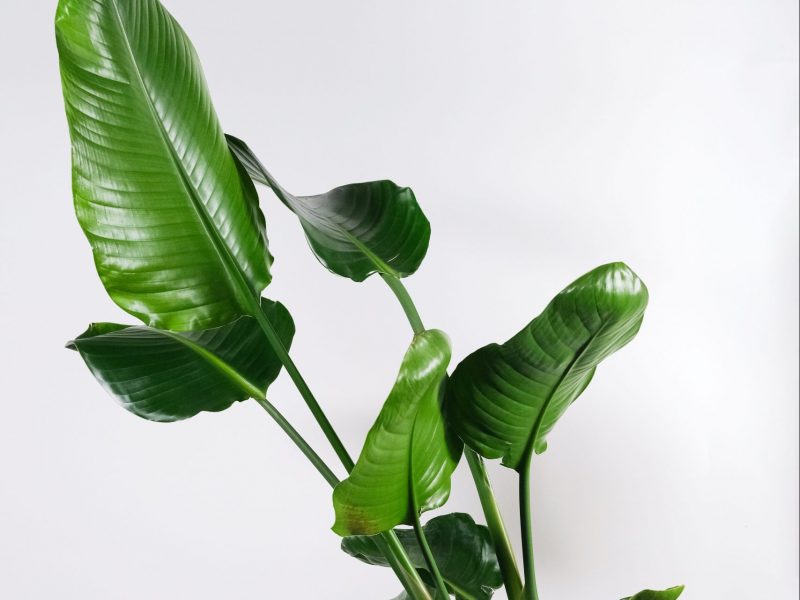Bird of Paradise Leaves

Overview of the Bird of Paradise Plant
The Bird of Paradise (Latin name: Strelitzia Reginae) is a striking houseplant, famed for its distinctive, vibrant blooms that mirror the appearance of tropical birds in flight. Native to South Africa, this plant has found its way into homes worldwide, thanks to its unique aesthetic, large bold leaves and adaptability to indoor environments.
Characteristics:
- Evergreen, large and glossy leaves
- Known and loved for its dramatic flowers that resemble a bird in flight (hence the name).
- Can grow up to 6 feet indoors, though it typically remains around 3-4 feet in domestic environments.
Botanical Name: Strelitzia Reginae
Common Name: Bird of Paradise, Crane Flower
Species Varieties
While the most commonly encountered variety is the Strelitzia Reginae, there are in fact five distinct species of Bird of Paradise plants.
- Strelitzia Reginae: This is the most common variety, with orange and blue flowers.
- Strelitzia Nicolai: Known as the Giant Bird of Paradise, this variety can reach up to 30 feet in height in its natural habitat.
- Strelitzia Alba: This species sports pure white flowers, a rarity in the Bird of Paradise family.
- Strelitzia Juncea: This variety has leafless stems, giving it a more desert-like appearance.
- Strelitzia Caudata: Known as the Mountain Strelitzia, this variety can be found in the eastern parts of South Africa.
Lighting Requirements for the Bird of Paradise Plant
The Bird of Paradise, with its lush, tropical foliage, is a plant that relishes bright, indirect sunlight. Natives to South Africa, these exotic beauties are accustomed to receiving plenty of light. However, too much direct sunlight can damage their leaves, causing them to dry out, turn brown and yellow or even burn (you’ll notice scorched patches if this happens).
Ideal conditions for your Bird of Paradise is when it receives plenty of bright but indirect light. While the Bird of Paradise can handle some direct sunlight, it’s best to limit this, especially during hot summer months as the sun can be quite strong and harsh.
If your home struggles to get enough natural light, don’t worry as this plant is relatively hardy and can tolerate lower light levels, although this may slow its growth. You can also supplement light levels with an LED grow light during winter to ensure your plant is still getting enough light.
Top tip: Rotate the plant every couple of weeks. This simple action ensures all sides get an equal amount of light and promotes more balanced growth.
Watering your Bird of Paradise Correctly
When to Water:
- Your Bird of Paradise will thrive with consistent watering but make sure the top inch of soil is dry before watering again.
- Avoid letting the plant sit in water. If you notice standing water in the saucer after watering, be sure to drain it.
- Keep in mind, however, that your plant’s watering schedule will also depend on the season, its pot size, the amount of light it receives, and the humidity levels in your home.
- On average you want to be watering once a week in summer and once every two weeks in winter but adjust this to fit your individual plant.
How to Water:
- When watering, do so thoroughly, making sure the water reaches the entire root ball. This ensures all roots have access to moisture.
- Use lukewarm or room temperature water, as cold water can shock the plant.
- Water directly into the soil, avoiding the leaves and crown of the plant to prevent potential disease issues.
Humidity Needs of the Bird of Paradise Plant
The Bird of Paradise thrives in a humid environment, reflecting its tropical origins. However, it doesn’t mean you need to transform your living room into a rainforest. We recommend aiming for a humidity level around 50-60%. A few simple adjustments can make all the difference and prevent issues such as dry brown leaf tips and edges.
- Regular Misting: Use a spray bottle to mist your Bird of Paradise leaves at least once or twice a week. This not only increases humidity but also keeps the leaves dust-free.
- Humidity Tray: Another effective method is placing your plant on a tray filled with pebbles and water. As the water evaporates, it creates a microclimate of increased humidity around the plant.
- Grouping: Group your Bird of Paradise with other plants. Plants naturally increase humidity by releasing moisture into the air, a process known as transpiration.
- Humidifier: Consider investing in a humidifier, especially during the dry winter months as this will keep a nice stable humidity level for you.
Note: Excessive humidity can lead to fungal problems. Therefore, keep a balance and ensure good air circulation around your Bird of Paradise.
Bird of Paradise Temperature Requirements
The Bird of Paradise is a tropical plant that thrives in a warm environment. This stunning houseplant, native to South Africa, is accustomed to a stable climate. Daily temperature fluctuations should be minimal, with an ideal range between 64 to 81°F (18- 27°C).
Winter Care
During winter, the Bird of Paradise can tolerate cooler temperatures, but never below 50°F (10°C). Extended exposure to cold can result in leaf damage.
Summer Care
In the summer, the plant enjoys warmth but is not a fan of excessive heat. Temperatures above 86°F (30°C) can cause wilting. In summer you also want to watch out for damaged caused by air conditioning units as if your plant is positioned too close to the vent, this can cause problems.
Flowering Bird of Paradise

Fertilizing Your Bird of Paradise Plant
Understanding Fertiliser Types
Not all fertilisers are created equally. For the bird of paradise, a slow-release granular fertiliser with a high phosphorus content is recommended. Phosphorus (the ‘P’ in NPK ratios) encourages blooming which is really important for your Bird of Paradise plant.
The Right Time to Fertilise
Fertilising should occur during the growing season, typically from early spring to early autumn. During this period, applying fertiliser once every two to three weeks is advisable. Then when winter approaches, cut back fertilizing completely as your plant enters the dormant phase.
Top tip: Before you begin, ensure your plant is thoroughly watered. This prevents the roots from being burned by the fertiliser.
Recognising Over-fertilisation
While fertilising your Bird of Paradise is important, overdoing it can lead to damage. Signs of over-fertilisation include wilting, yellowing leaves, and brown leaf tips. If you notice these symptoms, check for other causes before stopping fertilisation and flushing the soil with clean water to remove excess nutrients.
Flowers on a Bird of Paradise
The Bird of Paradise is renowned for its brilliant, uniquely structured flowers. Their resemblance to the flamboyant bird species of the same name has earned this tropical beauty its common name.
The flowering process
The plant typically needs to be at least 4-5 years old before it begins to flower. Even then, patience and optimal growing conditions are key to coaxing it into bloom. This includes enough sunlight (a minimum of 4-6 hours of bright, indirect sunlight each day), warm conditions, regular watering and a regular routine of fertilizing with a balanced, slow-release fertiliser.
Factors impacting blooming
Despite meeting these conditions, there are factors that may prevent your Bird of Paradise from blooming. These include inadequate light, temperature fluctuations, and cramped roots. In such cases, adjust the care conditions accordingly.
Choosing the Right Pot and Soil
Choosing the Right Pot
When selecting a pot for your Bird of Paradise, consider the plant’s robust size and rapid growth. The pot needs to accommodate the roots, providing them with enough room to comfortably spread out. A pot that’s too small will restrict growth, while one that’s too large may lead to waterlogging.
- Size: A pot with a diameter of about 30-40 cm is a good starting point for young plants. As the plant matures, you may need to upgrade to a larger pot.
- Material: Ceramic or terracotta pots are recommended for their durability and breathability. They also provide a good balance of weight to prevent the plant from toppling over.
- Drainage: Ensure your chosen pot has sufficient drainage holes. This will prevent water from pooling at the bottom of the pot and causing root rot.
Selecting the Right Soil
Bird of Paradise plants prefer a well-draining soil mix that can hold moisture without becoming waterlogged. The right soil mix will provide the necessary nutrients and promote healthy root growth.
- Soil Mix: A high-quality, well-draining potting mix is ideal. Mixes designed for cacti and succulents, which contain perlite, sand, or bark to enhance drainage, can also work well.
- pH Levels: Bird of Paradises prefer slightly acidic to neutral pH levels, between 6.0 and 7.5. Regularly testing soil pH and adjusting as necessary will help keep your plant healthy.
- Organic Matter: Adding organic matter such as compost or well-rotted manure will enrich the soil, providing additional nutrients and improving soil structure and moisture retention.
Bird of Paradise

Repotting a Bird of Paradise
When to Repot
The best time to repot a Bird of Paradise is in the spring or early summer. This is when the plant is in its growth phase and can cope with the disturbance. If the roots are visibly cramped or poking out of the drainage holes, you should repot straight away even if it’s not the most ideal time of year.
Choosing the Right Pot
Select a pot that’s slightly larger than the current one, approximately 2 inches wider in diameter. You also want to make sure that it has sufficient drainage holes to prevent the plant from getting waterlogged. A ceramic or terracotta pot is usually the best choice for a Bird of Paradise as it provides excellent drainage and stability.
Repotting Process
- Preparation: Fill the new pot with a layer of fresh potting soil, enriched with slow-release fertiliser.
- Removal: Carefully remove the plant from its current pot and shake off some of the oil soil from around the roots.
- Placement: Place the plant in the centre of the new pot, adding more new fresh soil as necessary to ensure the plant is at the same depth as in its previous pot.
- Completion: Fill in around the plant with additional potting soil, firming it gently with your fingers. Water lightly.
Propagation Techniques for the Bird of Paradise Plant
Propagation of the Bird of Paradise plant isn’t a simple task as new growth can be slow and even the logistics of propagating such a large plant can be difficult. However, it can be very successful when done right! Below are the two main methods to propagate your Bird of Paradise plant.
Sowing Seeds
Sowing seeds is the traditional propagation method. It’s a long process that requires patience, but being able to nurture the plant from its earliest stage can be incredibly rewarding.
- Begin by soaking Bird of Paradise seeds in warm water for 24 hours.
- Next, plant the seeds 1 inch deep in a pot filled with a mix of perlite and peat moss.
- Maintain a temperature of around 25°C and ensure the soil is consistently moist.
- Wait patiently. Germination can take anywhere from 4 weeks to 3 months.
Division Method
Division is a quicker propagation method but this technique works best with older, mature plants that have become too crowded.
- Firstly, remove the plant from its pot and gently separate the root clump into sections. Each section should have at least one leaf.
- Once divided, plant each section in a new pot filled with well-draining potting mix.
- Water each new plant thoroughly and place it in bright, indirect light.
Cleaning the leaves of your Bird of Paradise
Keeping the Bird of Paradise’s leaves clean is not just a matter of aesthetics, but it’s also crucial for the plant’s health. Dust and grime can clog leaf pores, which reduces the amount of light that the leaves can take in.
Steps to Clean Your Bird of Paradise Leaves
- Dampen your cloth – Dip a cloth into warm soapy water and wring it out until it’s just damp.
- Wipe each leaf – Gently wipe the top and bottom of each leaf. Be careful not to scrub or apply too much pressure.
- Rinse: Use your watering can or spray bottle to gently rinse the soap off the leaves. Avoid wetting the soil if it has recently been watered.
- Blot dry: Gently blot dry the leaves with a clean cloth to prevent water spots.
Bird of Paradise Toxicity to Pets and Humans
Toxicity in Pets
Sadly, the Bird of Paradise is toxic to cats and dogs. If ingested, it can cause symptoms such as drooling, vomiting, and lack of appetite.
Toxicity in Humans
While it’s less common for humans to ingest houseplants, accidents can happen, especially with children. If any part of the Bird of Paradise plant is ingested, it can cause mild to moderate symptoms ranging from nausea and vomiting to abdominal pain.
Seek immediate medical or veterinary attention if ingestion occurs.
Treating Pests and Diseases
Even a robust houseplant like the Bird of Paradise is not immune to pests and diseases. It’s essential to regularly inspect your plant for signs of trouble as treating the problem early will give you a higher chance of successfully getting your plant back to full health.
Common Pests
Common pests that may plague your Bird of Paradise include spider mites, scale insects, and mealybugs. These pests suck sap from the plant, causing yellowing, wilting, and stunted growth.
- Spider Mites: These tiny creatures can be hard to spot but cause considerable damage. If you notice a fine, spiderweb-like substance on your plant, you likely have a spider mite infestation.
- Mealybugs: Aptly named for their cotton-like covering, mealybugs can quickly spread, so swift action is necessary.
- Scale Insects: If you see small, bumpy growths on your plant’s stem or the underside of leaves, you’re likely dealing with scale insects.
To treat any of these pests, wipe the leaves with a soft cloth soaked in a mixture of water and mild dish soap and use an insecticide or neem oil with a more serious and larger infestation.
Diseases
Bird of Paradise plants can be susceptible to fungal diseases like root rot and leaf spot. Both these conditions thrive in overly wet conditions and can cause serious damage if left untreated.
- Root Rot: If your plant’s leaves are yellowing and wilting despite sufficient watering, you may have root rot. This is caused by overwatering and poor drainage.
- Leaf Spot: Brown spots on your plant’s leaves are often a sign of this fungal disease. High humidity and poor airflow contribute to its development.
The best treatment for these diseases is prevention. Ensure your Bird of Paradise has well-draining soil and is not sitting in water. If you do spot these diseases, remove the affected parts of the plant and adjust your watering schedule.
Bird of Paradise FAQs
How do I get my Bird of Paradise to produce flowers?
Bird of Paradise plants will only bloom when mature and it can take several years before this starts to happen. Then your plant needs to be getting the right amount of light to aid healthy growth and flowers. The last thing you can do is give your Bird of Paradise fertiliser during the growth period to aid this.
Are Bird of Paradise plants toxic?
Yes Bird of Paradise plants are toxic to humans and pets and can cause serious stomach issues if ingested.
How much water does a Bird of Paradise need?
Bird of Paradise plants prefer a little and often way of watering, this keeps the soil moist but never wet and soggy. They can be prone to root rot so it’s important that you get the drainage right, make sure your pot isn’t holding in any excess moisture.
How big do Bird of Paradise plants get?
Bird of Paradise plants can reach about 2 meters if they are given the right care and enough space in the pot to grow.
Can Bird of Paradise plants survive indoors?
Yes, although they are a tropical houseplant, they can adapt well to our homes and there is no reason that with the right care, light levels and temperature that they can’t thrive indoors.
Common Problems with your Bird of Paradise
Here are some common issues that you might run into. It’s important to diagnose any issues early to give your plant the best chance of bouncing back.
Why does my Bird of Paradise have splits in its leaves?
This is very common with Bird of Paradise and actually doesn’t mean anything is wrong at all. They develop these splits in the wild to make them more resistant to the wind.
Why won't my Bird of Paradise flower?
It’s very rare to get the Bird of Paradise to flower or bloom indoors. If you have a brighter spot in your home that you could move the plant into, this would give it the best shot at blooming.
Why does my Bird of Paradise have curling leaves?
This is most likely down to a lack of humidity in the environment, to increase the humidity try spraying the plant down with a mist bottle every week or placing it on a pebble tray topped up with water.














